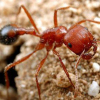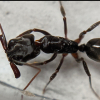neivamyrmex is a native genus tho. I'm suggesting we take them out of the deep woods or mountains and release them in residential areasLike I was saying earlier, I'm guessing most of the people saying they think we should release tropical species into an area to take care of Linepithema and Solenopsis only think it would be a good idea because they see an opportunity to keep their favorite exotics without a permit. Let me say it one last time, it is a horrible idea and will only make things worse for the environment!That's the worst idea I've heard. Know why Eciton move so often, more than any other doryline? It's because they kill and eat so much they need to move to new foraging grounds or they will starve. That's fine in a rainforest with huge biodiversity and density, but few other environments could support ants like those. The entire system would collapse. Eciton wouldn't even bother with argentines, they would go for birds.As long as we're using non native ant species to combat other non native ant species (which often doesn't work, btw), we might as well use some other more common army ant genus such as Eciton.what about in places like Florida where neivamyrmex don't hibernate? N. Opacithorax is found in the keys and preys on tramps like invicta.
Edited by Manitobant, January 16 2020 - 5:30 PM.






















